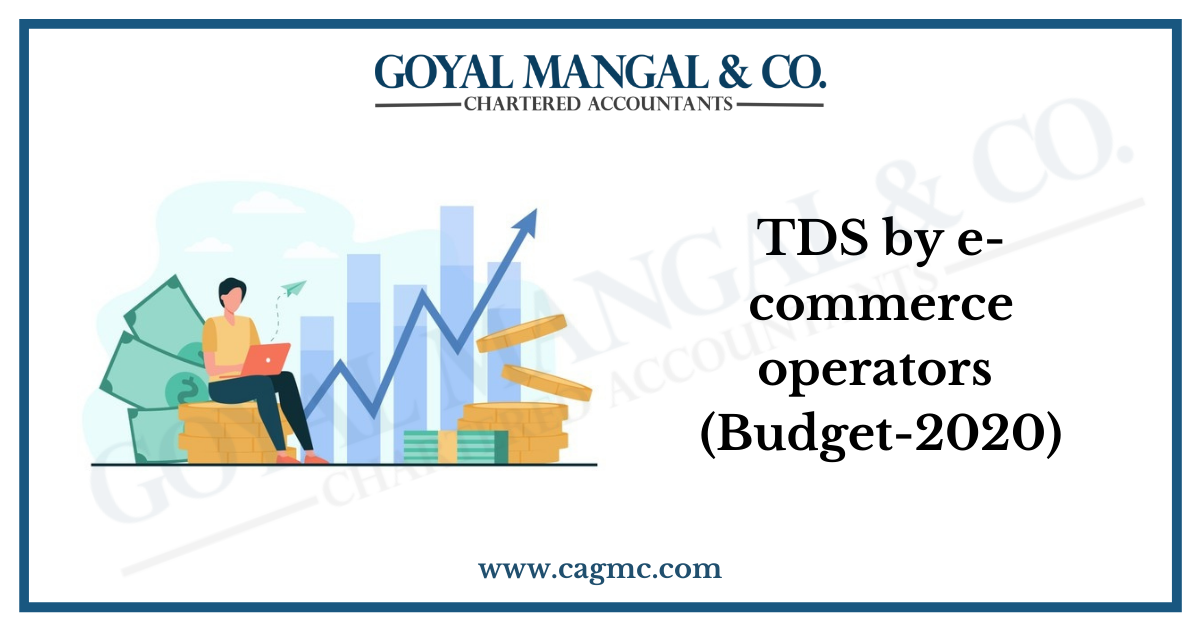In Budget, 2020 finance minister Nirmala Sitaraman has proposed to Insert sec 194-O, where E-commerce Operator like Amazon, Flipkart, Paytm are liable to deduct TDS from payment made to their registered sellers at rate of 1%, at time of credit or payment whichever is earlier.
Motive behind this new section is to bring the e-commerce sellers/service providers within the tax regime i.e. there will be transparency on the income earned by seller of goods/provider of service through E-commerce platforms.

Important Provisions of this section
- What is TDS?
As the name suggests, the concept of TDS is to deduct tax at its source. As per the Income Tax Act, any company or person making a payment is required to deduct tax at source if the payment exceeds certain threshold limits.
- Who is liable to deduct TDS ?
The TDS is to be paid by e-commerce operator like amazon, flipkart, Paytm who are the mediator between seller and buyer.
- When to deduct TDS ?
At the time of credit or payment, whichever is earlier. Credit means credit to the account of e-commerce sellers and payment means payment through any mode ( cash, neft, rtgs…)
- Applicability of TDS on transactions of E-Commerce operators
E-commerce is a platform where buying and selling of goods or services or both proceeds through an electronic medium
E-commerce operator means any person who operates or manages digital or electronic facility or platform for electronic commerce and also responsible for paying the amount to e-commerce participant. Eg. Amazon, Flipkart, Myntra, Facebook etc.
If a buyer of goods or service has made payment directly to e-commerce seller it shall be deemed that payment has been made by e-commerce company or account has been credited by e-commerce operator and same shall be added in gross amount for the purpose of deduction of tax.
- TDS at 1% on E-commerce operators
Union Finance Minister Nirmala Sitaraman said in her budget speech
“In order to widen and deepen the tax net, it is proposed to provide that e-commerce operators shall deduct TDS on all payments or credits to e-commerce participants at the rate of 1% in PAN/Aadhaar cases and 5% in non-PAN/Aadhaar cases.”
- The deduction of TDS- 1% on gross amount of sale.
- NO TDS to be deducted on GST component on service if same is separately shown on invoice.
- TDS not required to be deducted where participant dealer is Individual or HUF, having furnished PAN or Aadhar and gross amount of sale of goods or services or both, for that operator, during financial year, does not exceeds INR 5 Lacs.
- This section will be applicable on e-commerce participant being resident in Indiaselling the goods / providing services through E-commerce platform i.e. for non-residents this section will not applicable.
- E Commerce operator may apply to lower rate of TDS u/s 197
- If PAN or Aadhar not furnished TDS to be deducted at the rate of 5%
- TDS to be deducted for amount received or receivable by operator in respect of advertisement or other service not in relation to sale of goods or services or both.
- This proposal is going to take effect from 1 st October 2020.
- This TDS is in addition to the 1% tax that is already deducted under the goods and service tax Act ( GST).
To understand the provision clearly let’s have a look at an example,
- Let’s assume ‘ABC’, a partnership firm. ‘ABC’ runs a trading business of goods and selling its products an e-commerce website Amazon India. The company Amazon India runs the website. Here, in this case, Amazon India is the e- commerce operator company and ABC is the e-commerce participant
- Now, let’s further assume ‘B’ is an Indian resident who buys goods from Amazon India and pays Rs. 10000 for the same. After deducting commission, service fee, and taxes, Amazon India is about to remit Rs. 9000 to ABC. Now with the introduction of this provision, Amazon India needs to deduct 1% tds from this amount and remit only the remaining amount to the seller ABC.
Post reading the above we can analyse that revenue to going to cover up each and every area from where a person can do the business and is on the way that nothing will be left out from the ambit of the revenue from the tax collection point of view.


